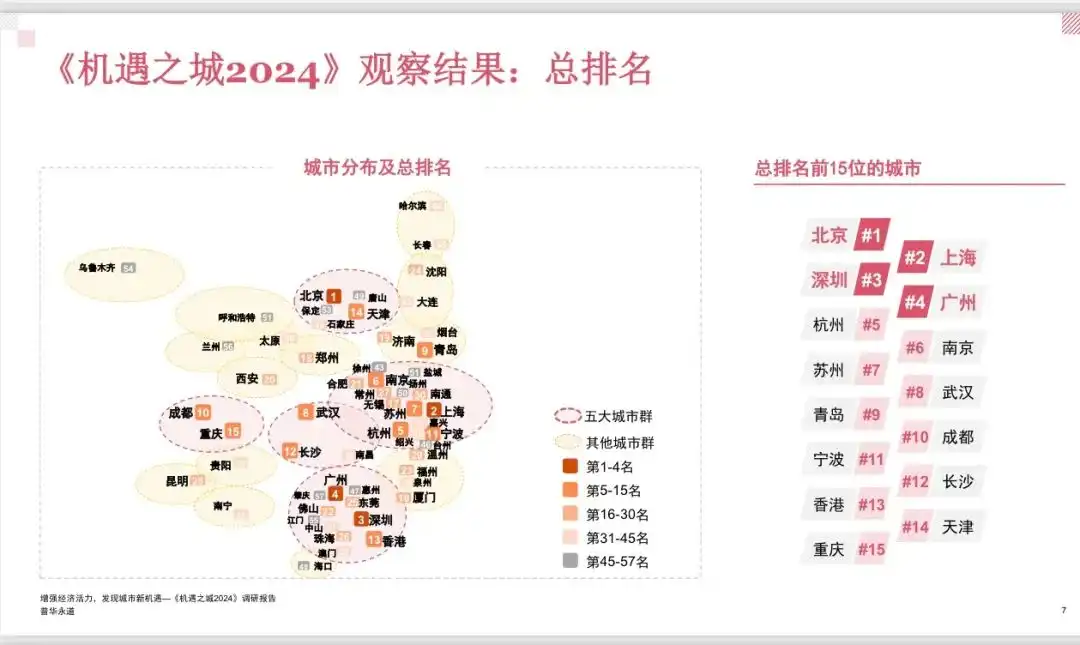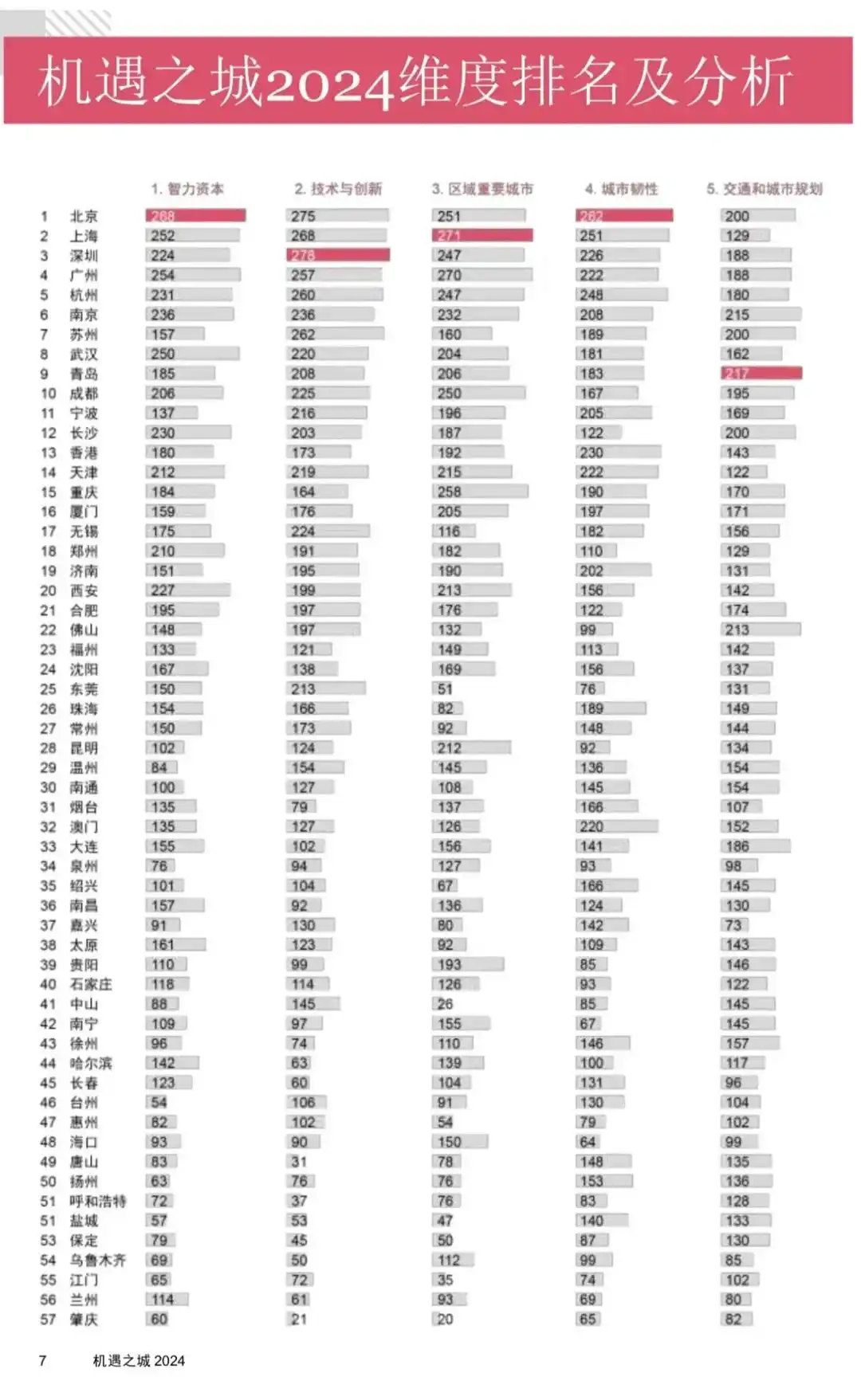City of Opportunities 2024 report:City rankings in dimensions such as intellectual capital, technological innovation, and business-friendly environment
■China Economic Times reporter Liu Hui
** **
On March 20, the China Development Research Foundation and PricewaterhouseCoopers jointly released the "City of Opportunities 2024" report, which conducts comprehensive follow-up and observation of Chinese cities. The report surveyed 57 cities and based on retrospective observation of urban development data, look for diversified and multi-level development opportunities for the city.

According to the "City of opportunity 2024" report, the top five cities are Beijing, Shanghai, Shenzhen, Guangzhou and Hangzhou, while the top five cities in intellectual capital are Beijing, Guangzhou, Shanghai, Wuhan and Nanjing. the top five cities in technology and innovation are Shenzhen, Beijing, Shanghai, Suzhou and Hangzhou, while the top five cities in the region are Shanghai, Guangzhou, Chongqing, Beijing and Chengdu. The top five cities in urban resilience are Beijing, Shanghai, Hangzhou, Hong Kong and Shenzhen, while the top five cities in transportation and urban planning are Qingdao, Nanjing, Foshan, Beijing, Suzhou and Changsha (tied for 4th). The top five cities for sustainable development are Ningbo, Fuzhou, Zhuhai, Changsha and Haikou (tied for 4th). The top five cities in culture and life are Shanghai, Beijing, Hangzhou, Guangzhou, Shenzhen and Nanjing (tied for fifth place). The top five cities with economic influence are Beijing, Shanghai, Hong Kong (tied for 1st place), Shenzhen and Hangzhou. The top five cities in cost are Tangshan, Baoding, Shijiazhuang, Hohhot and Yantai. The top five cities with business friendly environment are Shenzhen, Suzhou, Shanghai, Hangzhou and Beijing.

The "City of Opportunity" research report has been released for 11 consecutive issues since 2014. The report focuses on observing the characteristics and potential of each city. This year's 57 cities cover the central cities and node cities of many major urban agglomerations in China, such as the Beijing-Tianjin-Hebei urban agglomeration, the Yangtze River Delta urban agglomeration, the Guangdong-Hong Kong-Macao Greater Bay Area, Chengdu-Chongqing urban agglomeration, the middle reaches of the Yangtze River urban agglomeration, the Shandong Peninsula urban agglomeration, the Central Plains urban agglomeration, and the Guanzhong Plain urban agglomeration, etc.
Fang Jin, secretary-general of the China Development Research Foundation, said that cities are an important carrier for China to achieve high-quality development and provide important spatial support for building a new development pattern. In the process of new urbanization development, many cities combine their own industrial foundations and cultivate characteristic industries according to local conditions to achieve economic growth.
Yu Jiantuo, deputy secretary-general of the China Development Research Foundation, said that the "14th Five-Year Plan" proposes from a strategic perspective to "promote a new urbanization strategy with people at the core", and cities carry people's yearning for a better life. "With the gradual expansion of the scope of observation of Chinese cities in the" City of Opportunity "report, we have not only witnessed the development process of many leading cities in China, but also discovered new development momentum in many emerging cities, providing an international perspective and work reference for the development of China's new urbanization."
Liang Weijian, managing partner of PricewaterhouseCoopers China Market, said that the development of strong high-tech industries and the expansion of sustainable green economic models will bring new development momentum and create new development opportunities for China's high-quality urbanization development.
According to the observation results of "City of Opportunity 2024", the top cities have performed well in terms of balanced development, and they all rank among the top in multiple dimensions. Beijing, Shanghai, Shenzhen and Guangzhou continue to lead the development of Chinese cities, followed by Hangzhou, Nanjing, Suzhou, Wuhan, Qingdao and Chengdu entering the top ten. From the perspective of urban agglomerations, the cities of the three major urban agglomerations of Beijing-Tianjin-Hebei, Yangtze River Delta, and Guangdong-Hong Kong-Macao Greater Bay Area have performed steadily. The overall performance of the observed cities of Chengdu-Chongqing Urban Agglomeration, Shandong Peninsula Urban Agglomeration, and Middle Yangtze River Urban Agglomeration is relatively excellent. The development momentum and radiation range of urban agglomerations continue to expand, and the formation of connections and driving forces between urban agglomerations have led to an improvement in the overall degree of urbanization development.
The report shows that Chinese cities are currently actively seeking new development opportunities and exploring new economic growth potential. Promoting industrial innovation through scientific and technological innovation and developing high-tech, high-efficiency, and high-quality new productivity is the mission of Chinese cities at present. In the stage of promoting the high-quality development of new urbanization, using urban agglomerations and modern metropolitan areas to drive coordinated regional development and promote integrated urban and rural development will be important goals and directions in the future.
Jin Jun, partner of PricewaterhouseCoopers China Trading Consulting, said that in recent years, some cities have relied on the development of strategic emerging industries to form a rising momentum. While forming strong investment appeal for cities, they have also contributed to the stable growth and sustainability of China's economy. Good support has been provided, and the rise of emerging cities also reflects the diversified, multi-level and multi-gradient characteristics of China's urban economic vitality. One model is that the rapid development of the core cities of the urban agglomeration drives the development of the entire urban agglomeration, such as Shenyang's drive to the Northeast region. Another model is the balanced development of cities. There is more than one core city in the urban agglomeration, and cities can better complement their advantages, such as the urban agglomeration in the middle reaches of the Yangtze River and the Chengdu-Chongqing urban agglomeration. Another model is the development of connected urban agglomerations, such as the Shandong Peninsula urban agglomeration, the overall rankings of Qingdao and Yantai have increased, and cities in the Fuzhou and Xiamen area have opportunities.
Zhou Xing, managing partner of PricewaterhouseCoopers 'northern China market and Beijing, said that the coordinated development of Beijing-Tianjin-Hebei is inseparable from the high-end leading and radiating role played by Beijing and Tianjin. The Beijing-Tianjin-Hebei region has advantages in intellectual capital, technology and innovation, and regional importance. Cities, urban resilience and other dimensions. The coordinated development of Beijing, Tianjin and Hebei will continue to advance in depth. The three places will further leverage their respective advantages, strengthen cooperation and exchanges, promote in-depth cooperation in industrial synergy, innovation synergy, market synergy and other aspects, and jointly commit to building a world-class city cluster in Beijing, Tianjin and Hebei.
Zhang Lijun, managing partner of PricewaterhouseCoopers China's regional economy and finance industry, said that the northwest region will usher in development opportunities. At present, China is vigorously developing artificial intelligence, etc., and there is still a lack of computing power in the market. Computing power requires not only chips and graphics cards, but also green electricity. In the future, it is impossible to rely on traditional energy to train large models. It is necessary to promote "computing in the east and west". Therefore, we must develop urban agglomerations in the northwest, southwest and central regions.
Yi Chengdong, a professor at the Department of Urban and Real Estate Management at the School of Management Science and Engineering at the Central University of Finance and Economics, said that China's urbanization rate will be 66% in 2023. Urbanization is in a slow growth stage and will reach around 70% in 2030. It will reach a peak of about 80% during the period from 2040 to 2050. This stage corresponds to the vigorous development stage of metropolitan areas and urban agglomerations, and the population will continue to concentrate in metropolitan areas and urban agglomerations.
